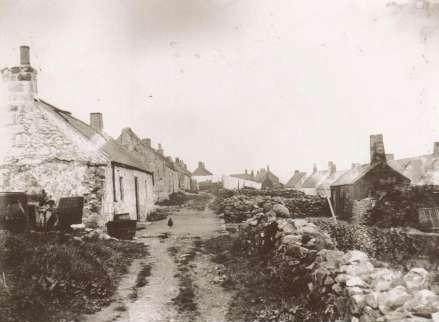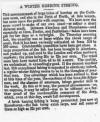
Herring Fishing |
A Press Article about local Herring Fishing - 1864.
 As early as the 1200ís the Dutch had been exploiting
herring around Scottish waters and they had their main base in Bressa
Sound in Shetland by the year 1230. By the end of the 1500ís the Dutch
had as much as a thousand large herring boats using the Sound and over
16000 men were employed there in what was a massive herring fishery.
As early as the 1200ís the Dutch had been exploiting
herring around Scottish waters and they had their main base in Bressa
Sound in Shetland by the year 1230. By the end of the 1500ís the Dutch
had as much as a thousand large herring boats using the Sound and over
16000 men were employed there in what was a massive herring fishery.
It took Scotland nearly 500 years of watching the Dutch building up their herring industry with fish caught in our own coastal waters before we finally woke up and realised that we could and should be part of this industry and by 1760 Scotland, at last, proved that they could make a success and started putting together a worthy herring fishing fleet.
 The town of Wick was the first east coast pioneer of the
great herring boom of the 1800ís. Fraserburgh was next and was soon
followed by Macduff, Banff, Portsoy, Lossiemouth and then Peterhead. The
harbours were modified to accommodate additional boats and gutting and
curing yards were set up in those harbours as the century progressed. By
the 1880ís sail boats were beginning to be used in the pursuit of the
herring and we saw the introduction of the famous and more efficient
Skaffies, Fifies and Zulus.
The town of Wick was the first east coast pioneer of the
great herring boom of the 1800ís. Fraserburgh was next and was soon
followed by Macduff, Banff, Portsoy, Lossiemouth and then Peterhead. The
harbours were modified to accommodate additional boats and gutting and
curing yards were set up in those harbours as the century progressed. By
the 1880ís sail boats were beginning to be used in the pursuit of the
herring and we saw the introduction of the famous and more efficient
Skaffies, Fifies and Zulus.
How did this affect Portlethen and its neighbouring villages? The problem with herring and our immediate coast was the unpredictability of shoals of fish showing up at all. For periods of three or four years there would be no sign of a herring and then one year, without any prior warning, huge shoals would show up here. This made it economically unviable for the local fishers to invest heavily in equipment such as drift nets and invariably when the herring showed up along our coasts the fishers were unprepared and unable to reap the benefits.
 Those local fishers who had invested in drift nets
suitable for herring fishing therefore had to cast further afield and
head for the fishing grounds where shoals of herring were more
commonplace and guaranteed. This often meant heading as far away as the
Moray Firth in the north or southwards towards the Firth of Forth.
Occasionally they would get lucky during a season where passing shoals
came close to our coast.
Those local fishers who had invested in drift nets
suitable for herring fishing therefore had to cast further afield and
head for the fishing grounds where shoals of herring were more
commonplace and guaranteed. This often meant heading as far away as the
Moray Firth in the north or southwards towards the Firth of Forth.
Occasionally they would get lucky during a season where passing shoals
came close to our coast.
On the whole our fishers tended to stick with fishing for cod and haddock and the tried and trusted methods of using line and hook. Good money could be made at the herring fishing but the unpredictability of the fish appearing on our coast meant that this type of fishing in our area was always secondary to the chase for cod and haddock.
